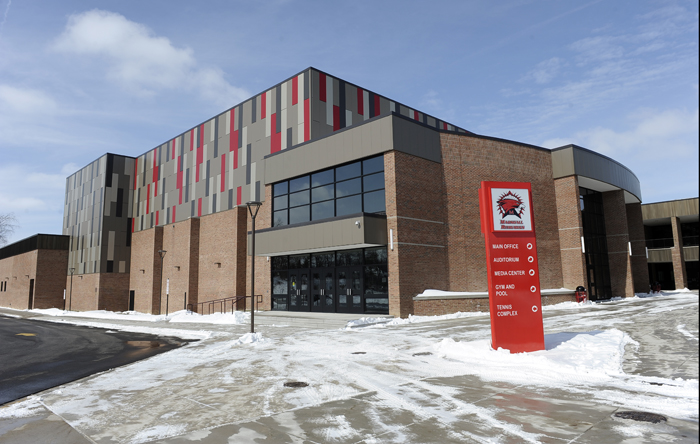13 MILES TO MARSHALL: Tough times lead very different high schools to merge (chapter 1)
The distance between Albion and Marshall can be measured in many ways: in miles, in money, in history, in skin color. Claiming a seat to herself on a bus plowing through the predawn darkness, De’Jhannique Straham put in her ear buds and gauged the gap between communities in her own way.
She stared out the window and listened to music as the bus exited Albion, rolling past what she called “all these run-down homes and businesses that aren’t open anymore. We get to Marshall, and the businesses look like they’re doing well, there are a lot of cars in front of them. The homes are bigger and nicer.”
Seven months ago, De’Jhannique and 159 other teens from low-income, predominantly African-American Albion High School began making the 13-mile journey to middle-class, overwhelmingly white Marshall High School. Since then, they’d hand-jived in “Grease” and twerked at Homecoming. They’d made friends and lost sleep. They’d studied more than ever for worse grades than ever. And they taught their new teachers the meaning of resilience.
Their journey is a story of race, poverty, community pride, and the Titanic-hits-iceberg dynamics of school funding in Michigan. Their story matters because their success or failure will likely play out again and again across Michigan, as school districts are forced by financial crises to collaborate, consolidate or close.
It is Albion kids on the bus today, but others will likely join them.
The soundtrack of De’Jhannique’s trip is the same each day, “Still Standing,” by Monica, a song that helps the senior believe in herself even when things are tough. “I know academically this is a good choice,” De’Jhannique said. “But sometimes it’s hard.”
It may be only 13 miles between Albion and Marshall but for the kids on the bus and the adults in charge, the journey has not always been easy.
A trip to the unknown
Mercedes Pace didn’t want to make that trip last spring, when the plan to move to Marshall was announced. She didn’t know about budgets or care about test scores or anything else the adults were arguing about. She was a 16-year-old cheerleader, and she wanted to fit in. She doubted that she and her Albion classmates would be accepted by kids in Marshall, a lot of whom seemed awfully rich by Albion standards, and who were virtually all white.
Some students from both schools were on edge about what would happen when 160 Albion students joined about 800 Marshall teens. Albion senior Shatoria Nicholson worried whether the Marshall kids would be racist. Marshall senior Megan Zoss feared Albion kids would come in and try to “take over the school.”
Parents were more outspoken. Marshall parents asked if the district’s test scores would go down when the Albion students walked through the door, damaging the school’s academic reputation. Some worried the high school didn’t have enough security. “You’ll get masked questions,” recalled Marshall Superintendent Randall Davis. “Behind it were issues of racism.”
Some Albion parents were more blunt. “They’d say ‘My child has never been in a majority white classroom, I don’t know if they’ll be accepted,’” said Albion Superintendent Jerri-Lynn Williams-Harper. “I’m 55 years old – I thought we were done with that.”
What people didn’t understand, Williams-Harper said, is “this isn’t about black and white, about your town and my town. It’s about the kids.”
It was also about money.
Two schools, one problem
The two Calhoun County communities, shoulder-to-shoulder along I-94 between Jackson and Battle Creek, were roughly the same size (under 10,000 residents), but had vastly different upbringings.
Albion was a factory town that had been hemorrhaging students and money ever since the factories began closing in the 1970s. By 2012, fewer than half of Albion’s children were attending Albion schools. The rest had fled to surrounding districts through schools of choice, a law that allows students to attend almost any school district in the state, if that district has room and is willing to accept outside students. White, middle-class families were opting out of the town’s schools, and taking their $7,000-a-year student allotment with them, leaving Albion’s public schools overwhelmingly black and poor.
Albion students were such easy pickings the neighboring districts of Springport, Homer and Concord sent school buses through the city’s neighborhoods each morning, practically bumper-to-bumper with Albion buses.
District enrollment dropped from 1,175 to 734 in five years, the equivalent of two busloads of kids leaving town every year. The district closed six school buildings in 15 years, and still couldn’t fill its remaining classrooms.
“Albion was strip-mined by school of choice,” said former Albion teacher Lisa Waddell. “We’d start out with 100 kindergartners, and by 7th grade, we’d have 40.”
Those who remained were often from the poorest families with few options. “They all wanted their children to succeed,” Waddell said. “But they had no idea how to help a teacher.”
Racial minorities made up 36 percent of Albion’s population in the 2010 U.S. Census, but 68 percent percent of the school enrollment. 100 percent of the students qualified for free and reduced lunch. Test scores dropped, and Albion became a regular on the Michigan Department of Education’s list of most troubled districts.
Students weren’t learning, and its funds were gone. “We had nothing,” recalled Albion Superintendent Jerri-Lynn Williams-Harper. “We were so broke, I said I can’t pay everyone on the payroll.”
Marshall, meanwhile, was having its own financial troubles. Marshall had always been a wealthier community than Albion, with patent medicines and railroads providing the cash for block after block of stately, late-19th Century homes that are now form a National Historic Landmark District.
The median household income in the Marshall school district is 80 percent higher than that in Albion schools. Six times more Albion families are on food stamps than Marshall residents.
None of that insulated Marshall schools from budget problems. The district was facing a projected deficit of between $1.2 million and $1.8 million for the 2013-14 school year – a problem faced by more and more districts across Michigan, urban, suburban and rural. Despite good test scores and sparkling facilities, the district had lost 372 students to school of choice, the equivalent of $2.6 million leaving town.
Marshall School Board President Vic Potter grimly described the two districts’ financial straits as “two death spirals.”
With Albion out of options and Marshall on the verge of major program cuts, the two frustrated superintendents – Williams-Harper and Davis – met behind closed doors in October 2012.
“You know, Randy,” Williams-Harper said, “I just need my babies to go to your school.”
13 MILES TO MARSHALL
READ CHAPTER 2
Michigan Education Watch
Michigan Education Watch is made possible by generous financial support from:
Subscribe to Michigan Health Watch
See what new members are saying about why they donated to Bridge Michigan:
- “In order for this information to be accurate and unbiased it must be underwritten by its readers, not by special interests.” - Larry S.
- “Not many other media sources report on the topics Bridge does.” - Susan B.
- “Your journalism is outstanding and rare these days.” - Mark S.
If you want to ensure the future of nonpartisan, nonprofit Michigan journalism, please become a member today. You, too, will be asked why you donated and maybe we'll feature your quote next time!


 Samantha Price, a Marshall junior, and Chris Bell, an Albion sophomore, are adjusting to life in the same school. The success or failure of the high school merger is likely to have implications across the state. (Photo by Lon Horwedel)
Samantha Price, a Marshall junior, and Chris Bell, an Albion sophomore, are adjusting to life in the same school. The success or failure of the high school merger is likely to have implications across the state. (Photo by Lon Horwedel) Marshall High School. New students from Albion began the school year behind their Marshall peers academically, and are adjusting to classes they say are more rigorous. (Photo by Lon Horwedel)
Marshall High School. New students from Albion began the school year behind their Marshall peers academically, and are adjusting to classes they say are more rigorous. (Photo by Lon Horwedel)